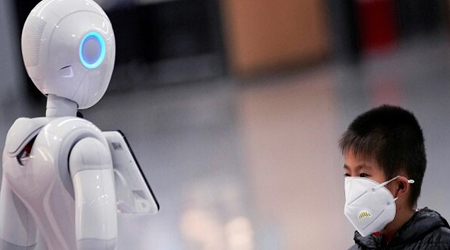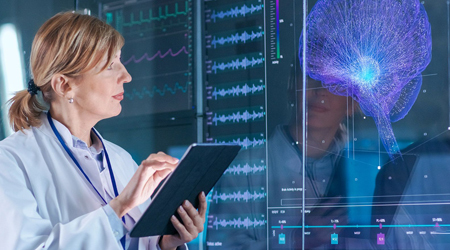Best Diagnostic Imaging Techniques for Using AI in Medical Diagnosis
 By Anolytics | 16 May, 2020 in AI in Healthcare | 5 mins read
By Anolytics | 16 May, 2020 in AI in Healthcare | 5 mins read

Artificial intelligence (AI) and machine learning have enough potential to make various tasks in the healthcare industry possible with accurate performance. Patient’s timely disease diagnosis and the right decision is an important part of hospitals to improve the overall healthcare system.
Medical imaging is playing a vital role in diagnosing the various types of diseases among patients across the healthcare system. MRI, CT Scan, Ultrasound and X-Rays are the key medical images use to diagnosis the disease, which is usually performed manually by the specialist doctors called Radiologists.
But now, Artificial intelligence in medical diagnosis is helping radiologists to use such images and detect the maladies with an acceptable level of accuracy. And now AI is capable enough to detect the different types of critical diseases with more level of accuracy.
To make AI model, learn and detect, similar medical images are used that are annotated by the experienced radiologist to make the affected areas recognizable to machines through computer vision. So, today we will discuss here types of medical diagnostic imaging used to train the machine learning models and what are the data annotation techniques to create such medical imaging training data for AI.
Types of Diseases Diagnosed with AI in Medical Imaging
Detecting the Neurological Abnormalities
AI in neuroimaging is now detecting brain-related injuries, blood clotting and other neurological disorders with a high level of accuracy. A team of Radiologists annotate and highlight such brain-related disorders and helping the algorithms learn from the same.
Once the machine learning algorithms, get fully trained to diagnose and predict the brain-related problems, it can be used on the place of radiologist making the medical imaging diagnosis process faster and more correct for timely detection of brain diseases.
Semantic segmentation and polygon annotation are the leading techniques used to label the medical imaging training data for brain-related abnormalities.
Screening of the Common Cancers
Cancer – one of the most common and deadly diseases, people are fighting to survive globally. Cancer is more life-threatening if diagnosed at last or critical stage of development. At this level, it becomes difficult for the oncologist to save the patients from dying from different types of common cancers.
Breast cancer and prostate cancer are the most common types of cancers found in individuals respectively taking their lives due to lack of timely detection. In breast cancer, microcalcification is the key tissue sometimes difficult to conclusively identify as it could be either malignant or benign.
Also Read: How Medical Imaging Datasets Can Help AI to Diagnosis the Covid-19 Like Deadly Virus
And if the diagnosis was false positives it could lead to unnecessary invasive testing or treatment, while missed malignancies could result in delayed diagnoses and worse outcomes for the patients. Similarly, AI deep learning” can detect the prostate and other types of cancers with accurate results.
Diagnosing the Infections in Kidney & Liver
AI is widely used and getting increasingly popular in the medical imaging of the liver, including radiology, ultrasound, and nuclear medicine. In liver medical imaging, physicians detect, characterize, and monitor diseases by assessing liver medical images visually.
However, sometimes, such visual assessment, done by experts or experienced radiologist doctors, may be biased due to personal experiences and inaccuracy. While on the other hand, AI can make a quantitative assessment by recognizing imaging information automatically instead of such qualitative reasoning as more accurate and reproductive imaging diagnosis.
Whereas, AI applications in kidney disease is currently no significant, but the potential of AI in the management of kidney disease is well recognized by clinicians, hence the role of AI in kidney disease diagnosis will improve the diagnosis process in the future.
Also Read: How To Improve Machine Learning Model Performance: Five Ways
Acute kidney problems like severe infections and stones can be detected with an AI-enabled medical imaging process. Basically, the function of AI in kidney disease mainly focuses on four aspects: Alerting systems, Diagnostic assistance, Guiding treatment and Evaluating prognosis.
And with well-organized and annotated training a deep learning models can predict the kidney failure possibilities among the patients suffering from kidney-related problems. To detect the kidney stones, bounding box annotation is used to make such ailments recognizable to machines.
Brain Tumor Detection with High Accuracy
Just like cancers, tumors are also life-threatening disease, especially if it is developed in the brain. And AI in brain tumor detection is also possible with a precise medical imaging technique. As per the various research, in brain tumor detection, the AI-based diagnosis was 94.6% accurate, compared to 93.9% interpretation done by pathologist.
Semantic segmentation technique is used to create such medical imaging data used for machine learning for brain tumor diagnosis. And as per the new studies, a novel method of combining advanced optical imaging with an artificial intelligence algorithm produces an accurate, real-time intraoperative diagnosis of brain tumors.
Also Read: How To Label Data For Semantic Segmentation Deep Learning Models
Machine Learning for AI in Dental Imaging Analysis
AI in dentistry for dental image analysis is playing an important role to find out the conditions of teeth helping doctors to recommend the right treatment. Using the dental image analysis, AI models can detect the teeth related problems including damaged teeth, uneven teeth structure or cavities and other maladies inside the roots of the teeth.
Also Read: How Machine Learning In Dentistry Can Improve The Dental Imaging Analysis
In dentistry, the affected or damaged teeth conditions are outlined in the X-Ray images by an experienced radiologist, once such data sets get ready, it is used in ML. The ML algorithm learns from varied types of annotated dental x-rays, and learn from such source data, that is further used to detect when shown such x-rays and predict the teeth condition.
Semantic segmentation is one of them used for detection, classification and segmentation of objects (teeth) in dentistry. Highly experienced dentist cum radiologist, examine the medical images or x-rays and annotate the affected areas with accuracy. They can create a huge amount of training data sets for machine learning in dentistry.
Also Read: How Much Training Data is Required for Machine Learning Algorithm
Detecting the Bone Fractures and Musculoskeletal Injuries
The invisible bone fractures and other hidden musculoskeletal injuries can be fatal if undetected or untreated for a long time. Hip fractures and bone injuries are more critical due to reductions in mobility and associated hospitalizations.
Also Read: How AI Robots Used in Medical Field: Types of Robotics in Healthcare
But medical imaging with machine learning, AI in fracture detection can diagnose the bone ruptures with the next-level of accuracy. X-ray imaging provides images of the body’s internal structures and when the fractured areas is annotated, it becomes delectable to machines through computer vision algorithm training with the huge amount of similar machine learning training data sets feed into the model.
Also Read: How Computer Vision Can Improve Accuracy of Diagnosis in Medical Imaging Analysis
Summing-up
AI in medical imaging is going to play a big role in diagnosing the various types of diseases including the critical maladies with a high level of accuracy. And further, with more improved or high-quality medical imaging data the diagnosis process and prediction accuracy will be better making the medical treatment and healthcare procedure more efficient and effective.
Also Read: How Artificial Intelligence in Healthcare is Going to Play a Key Role for Medical Imaging
And Anolytics is one of the leading data annotation companies, providing the machine learning training data sets for AI developments in different industries like automotive, retail, agriculture and healthcare etc. It is also offering a medical image dataset to train the AI models for diagnosing the various types of diseases with a high level of accuracy.
Anolytics works with a team of highly experienced radiologists and specialist doctors to precisely annotate the disease in the medical images using the right image annotation techniques to make it recognizable to computer vision-based AI models. It can produce such high-quality medical data sets with a scalable solution and complete data security at the best pricing.
please contact our expert.
Talk to an Expert →
You might be interested

- AI in Healthcare 27 Mar, 2020
How Big Data & AI is used in Healthcare System to Combat Coronavirus Outbreak?
Coronavirus or scientific name COVID-19, is one the most deadly virus of the century infected more than half of the mill
Read More →
- AI in Healthcare 11 Dec, 2020
Best Uses of Artificial Intelligence in Dentistry
Artificial intelligence (AI) is a branch of computer science that describes the research and development of computer-gen
Read More →
- AI in Healthcare 10 Jan, 2022
How AI is Improving Emergency Room Situations in Healthcare
Artificial Intelligence software and technologies have changed a multitude of industries in recent years, including educ
Read More →